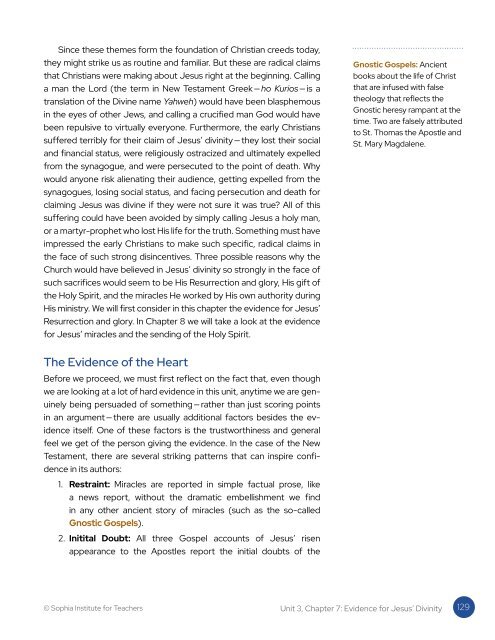CFS-WB-CH07
Create successful ePaper yourself
Turn your PDF publications into a flip-book with our unique Google optimized e-Paper software.
Since these themes form the foundation of Christian creeds today,<br />
they might strike us as routine and familiar. But these are radical claims<br />
that Christians were making about Jesus right at the beginning. Calling<br />
a man the Lord (the term in New Testament Greek — ho Kurios — is a<br />
translation of the Divine name Yahweh) would have been blasphemous<br />
in the eyes of other Jews, and calling a crucified man God would have<br />
been repulsive to virtually everyone. Furthermore, the early Christians<br />
suffered terribly for their claim of Jesus’ divinity — they lost their social<br />
and financial status, were religiously ostracized and ultimately expelled<br />
from the synagogue, and were persecuted to the point of death. Why<br />
would anyone risk alienating their audience, getting expelled from the<br />
synagogues, losing social status, and facing persecution and death for<br />
claiming Jesus was divine if they were not sure it was true? All of this<br />
suffering could have been avoided by simply calling Jesus a holy man,<br />
or a martyr-prophet who lost His life for the truth. Something must have<br />
impressed the early Christians to make such specific, radical claims in<br />
the face of such strong disincentives. Three possible reasons why the<br />
Church would have believed in Jesus’ divinity so strongly in the face of<br />
such sacrifices would seem to be His Resurrection and glory, His gift of<br />
the Holy Spirit, and the miracles He worked by His own authority during<br />
His ministry. We will first consider in this chapter the evidence for Jesus’<br />
Resurrection and glory. In Chapter 8 we will take a look at the evidence<br />
for Jesus’ miracles and the sending of the Holy Spirit.<br />
Gnostic Gospels: Ancient<br />
books about the life of Christ<br />
that are infused with false<br />
theology that reflects the<br />
Gnostic heresy rampant at the<br />
time. Two are falsely attributed<br />
to St. Thomas the Apostle and<br />
St. Mary Magdalene.<br />
The Evidence of the Heart<br />
Before we proceed, we must first reflect on the fact that, even though<br />
we are looking at a lot of hard evidence in this unit, anytime we are genuinely<br />
being persuaded of something — rather than just scoring points<br />
in an argument — there are usually additional factors besides the evidence<br />
itself. One of these factors is the trustworthiness and general<br />
feel we get of the person giving the evidence. In the case of the New<br />
Testament, there are several striking patterns that can inspire confidence<br />
in its authors:<br />
1. Restraint: Miracles are reported in simple factual prose, like<br />
a news report, without the dramatic embellishment we find<br />
in any other ancient story of miracles (such as the so-called<br />
Gnostic Gospels).<br />
2. Initital Doubt: All three Gospel accounts of Jesus’ risen<br />
appearance to the Apostles report the initial doubts of the<br />
© Sophia Institute for Teachers<br />
Unit 3, Chapter 7: Evidence for Jesus’ Divinity<br />
129


